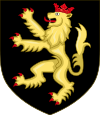User:JMvanDijk/Sandbox 9/Box 16
see: Imperial election
Prince-electors
[edit]From the 13th century, the right to elect kings in the Holy Roman Empire was granted to a limited number of imperial princes, the so-called prince-electors. There are various theories over the emergence of their exclusive election right.[1]

The secular electoral seats were hereditary. However, spiritual electors (and other prince-(arch)bishops) were usually elected by the cathedral chapters as religious leaders, but simultaneously ruled as monarch (prince) of a territory of imperial immediacy (which usually comprised a part of their diocesan territory). Thus the prince-bishoprics were elective monarchies too. The same holds true for prince-abbeys, whose prince-abbesses or prince-abbots were elected by a college of clerics and imperially appointed as princely rulers in a pertaining territory.
Initially seven electors chose the "King of the Romans" as the Emperor's designated heir was known. The elected king then went on to be crowned by the Pope. The prince-electors were:
Spiritual electors
[edit]Secular electors
[edit] The King of Bohemia, of the House of Luxembourg at the time of the Golden Bull, but from 1526 onward ruled by the House of Habsburg, who also ruled the Archduchy of Austria and Inner Austria. The Bohemian crown itself was also theoretically elective, but under the Habsburgs it became de facto hereditary.
The King of Bohemia, of the House of Luxembourg at the time of the Golden Bull, but from 1526 onward ruled by the House of Habsburg, who also ruled the Archduchy of Austria and Inner Austria. The Bohemian crown itself was also theoretically elective, but under the Habsburgs it became de facto hereditary. The Count Palatine of the Rhine, throughout the entire period a member of the House of Wittelsbach
The Count Palatine of the Rhine, throughout the entire period a member of the House of Wittelsbach The Duke of Saxony, from 1356 a member of the House of Ascania; from 1423, a member of the House of Wettin
The Duke of Saxony, from 1356 a member of the House of Ascania; from 1423, a member of the House of Wettin The Margrave of Brandenburg, from 1356 a member of the House of Wittelsbach; from 1373, a member of the House of Luxembourg; from 1415, a member of the House of Hohenzollern.
The Margrave of Brandenburg, from 1356 a member of the House of Wittelsbach; from 1373, a member of the House of Luxembourg; from 1415, a member of the House of Hohenzollern.
Subsequent changes
[edit]Later additions to the electoral council were:
 The Duke of Bavaria; of another branch of the House of Wittelsbach, granted elector status in 1623, replacing the Count Palatinate of the Rhine following the Bohemian Revolt.
The Duke of Bavaria; of another branch of the House of Wittelsbach, granted elector status in 1623, replacing the Count Palatinate of the Rhine following the Bohemian Revolt. The Duke of Brunswick-Lüneburg (also known as the Elector of Hanover) of the House of Welf, granted elector status in 1692. From 1714 the Duke was also the King of Great Britain.
The Duke of Brunswick-Lüneburg (also known as the Elector of Hanover) of the House of Welf, granted elector status in 1692. From 1714 the Duke was also the King of Great Britain.
Timeline of electors
[edit]- ^ Armin Wolf: Kurfürsten Archived 2015-11-18 at the Wayback Machine, article dated 25 March 2013 in the historisches-lexikon-bayerns.de portal, retrieved 16 August 2013





















